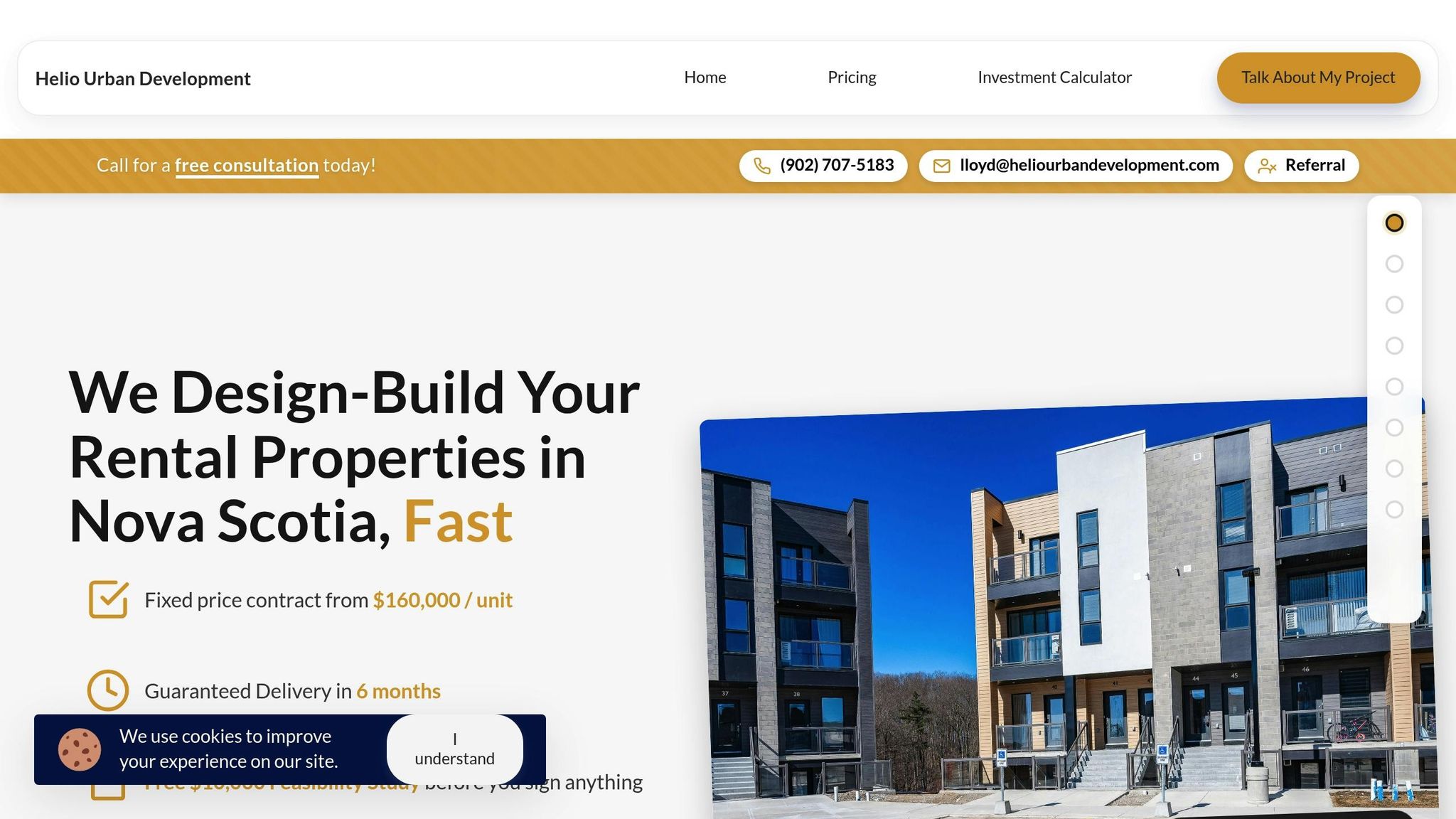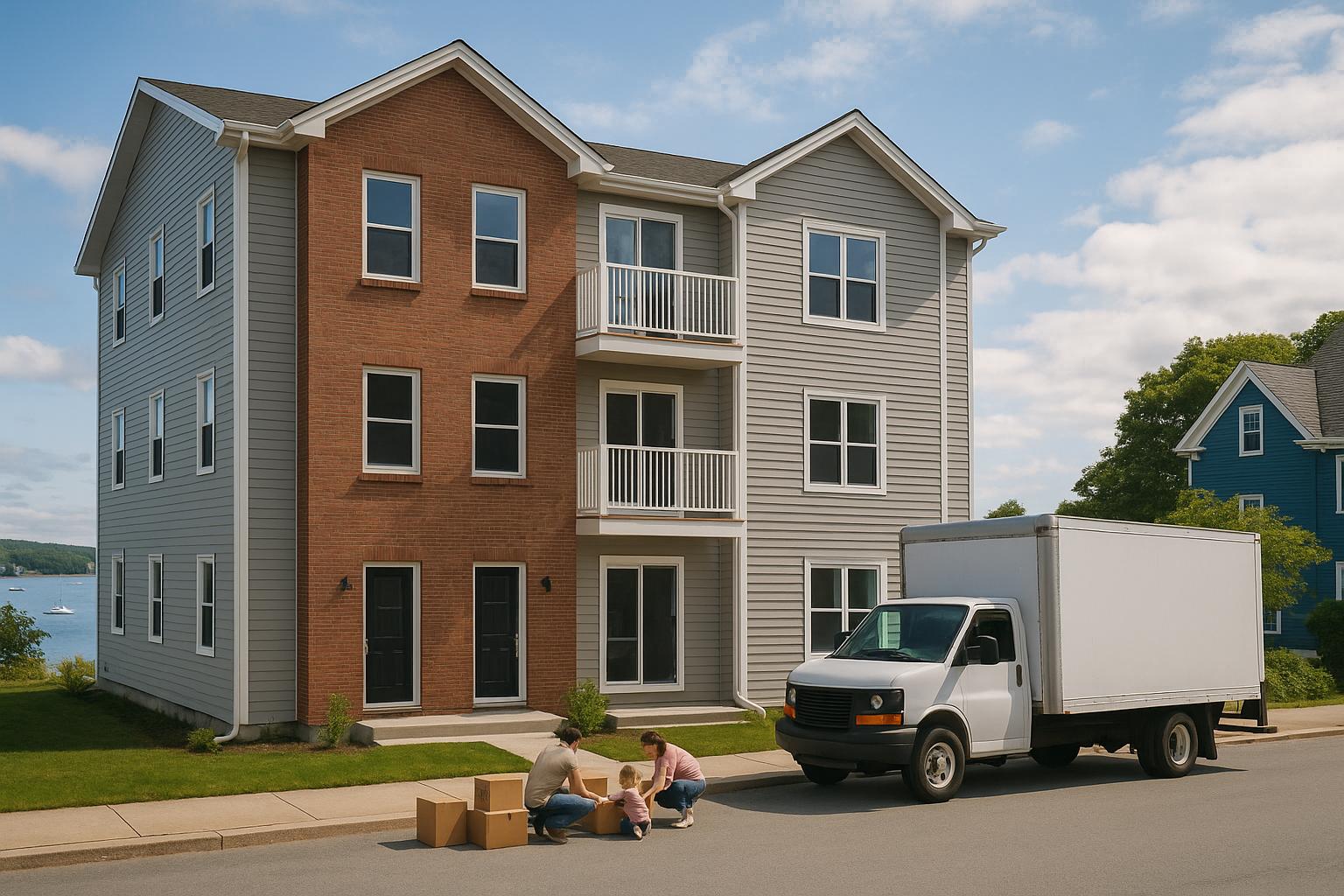The ER-2 Permit-Ready Package is a streamlined solution for property owners in Nova Scotia who want faster permit approvals for multi-unit rental projects. By consolidating all necessary documents - professionally stamped plans, engineering drawings, and compliance statements - into a single, organized package, the ER-2 approach eliminates delays caused by incomplete or disorganized submissions.
Key Benefits:
- Reduces permit review timelines from 12–18 months to as little as 6 months.
- Ensures compliance with the National Building Code of Canada and local municipal standards.
- Saves property owners an average of $47,000 in additional costs and up to $8,800/month in lost rental income.
What’s Included:
- Stamped site plans, floor plans, building elevations, and cross-sections.
- Supporting documents like location certificates, window schedules, and energy compliance reports.
- Adherence to Canadian standards (metric units, date formats, spelling).
The ER-2 package simplifies the process by aligning architects, engineers, and contractors under one team, minimizing errors and ensuring a smoother path to permit approvals. For Nova Scotia property owners, this approach offers a reliable way to keep projects on schedule while avoiding costly delays.
2. Introduction to Permitting, Planning, Licensing & Compliance - Customer Website
What's Inside the ER-2 Drawing Index
The ER-2 drawing index is designed to streamline the permit approval process, ensuring all necessary documents align with Nova Scotia's building standards and municipal requirements. It serves as a comprehensive guide to meet the specific needs of ER-2 zoning regulations.
Professional Stamped Plans and Drawings
At the heart of the ER-2 drawing index are the stamped architectural and engineering plans. These must be signed and stamped by licensed professionals registered in Nova Scotia, ensuring credibility and compliance.
- Site plans: These outline the placement of the building, property boundaries, setbacks, parking, and landscaping. They confirm that the project meets ER-2 zoning requirements, such as building height limits (8–11 metres) and setbacks[2].
- Floor plans: These provide detailed layouts of each unit, including room dimensions and circulation paths. They demonstrate adherence to standards for accessibility, fire safety, and minimum unit sizes.
- Building elevations: These showcase the exterior design from all sides, highlighting windows, doors, materials, and rooflines. Reviewers use these to ensure the building complements the neighbourhood and meets ER-2 design guidelines.
- Cross-sections: These cut-through views reveal internal structures, ceiling heights, and mechanical systems. They confirm the structural integrity of the building and proper fire separation between units and floors.
- Engineering documents: These include structural foundation details, mechanical systems (heating, ventilation, plumbing), and electrical layouts for power, lighting, and safety systems.
Together, these documents form the backbone of the ER-2 package, ensuring a smooth and efficient review process.
Required Supporting Documents
In addition to the main drawings, several supporting documents are critical to avoiding delays during the review process:
- Location Certificate: Prepared by a Nova Scotia Land Surveyor, this certificate confirms the building's exact placement on the lot, ensuring it fits within property lines and meets setback requirements[1].
- Window schedules: These list all windows in the building, specifying sizes, energy ratings, and installation details. They help confirm compliance with energy efficiency standards and adequate natural light for all units.
- Building code compliance statements: These written confirmations, prepared by licensed professionals, ensure the design meets all applicable regulations, including fire safety, accessibility, structural integrity, and mechanical systems. They align with the National Building Code of Canada and Nova Scotia-specific requirements.
Depending on the project's location and municipal guidelines, additional documents might include soil reports for foundation design, environmental assessments for sensitive areas, or heritage impact statements for properties in heritage districts.
Canadian Standards and Format Requirements
To maintain consistency and clarity, all documents in the ER-2 drawing index must adhere to Canadian standards for measurement, spelling, and formatting. This ensures submissions are easy to review and align with official practices.
- Metric measurements: Construction details use millimetres, while overall dimensions are shown in metres. Room areas are calculated in square metres, and lot sizes are either in square metres or hectares. Temperatures are recorded in Celsius, and structural loads are measured in kilopascals or kilonewtons.
- Canadian spelling conventions: Words like "centre", "colour", and "metre" must follow Canadian English. Technical terms also adhere to Canadian standards, such as "vapour barrier" instead of "vapor barrier."
- Date formats: Documents use the day/month/year format, ensuring consistency for revision dates, professional stamps, and preparation dates.
- Digital file formats: Municipalities typically require PDFs for drawings, Word documents for reports, and JPEGs for photos. File sizes must remain under 100 MB, and clear naming conventions should identify each document's purpose and revision date. Halifax Regional Municipality provides specific guidelines for digital submissions.
Professional stamps and signatures must be clearly visible and include the professional's registration number, signature date, and contact information, following the standards set by Professional Engineers Nova Scotia and the Nova Scotia Association of Architects.
Why Permit Reviewers Prefer This Drawing Index
In Nova Scotia, municipal permit reviewers often approve ER-2 packages faster than traditional submissions. Why? Because these packages are thorough and well-organized, making it easier for reviewers to verify compliance without needing to chase down missing details or request clarifications. Let’s break down how this streamlined approach speeds up the review process.
Clear Documentation Speeds Up Reviews
The ER-2 drawing index is designed for clarity, allowing reviewers to quickly locate the information they need without wading through disorganized files or unclear drawings. With professionally stamped plans presented in a consistent, Canadian-standard format, reviewers can efficiently verify critical details like setbacks, building heights, and unit layouts.
This level of organization supports a focused, single-session review process, reducing the need for multiple rounds of back-and-forth.
Complete Submissions Prevent Common Delays
Traditional submissions often hit roadblocks when key documents are missing or unclear. For example, incomplete site plans that lack property boundaries or setback details are a frequent cause of delays. The ER-2 package avoids these issues by including all necessary information upfront, ensuring the review process moves forward without unnecessary interruptions.
Another common issue with traditional submissions is outdated or missing professional stamps. These errors can trigger additional review cycles, leading to significant delays. In contrast, the ER-2 package ensures that all professional stamps are current and correctly applied, keeping the process on track.
Energy efficiency documentation is another area where traditional submissions can falter. Missing or incomplete compliance details often mean extra technical reports are needed, slowing down approvals. The ER-2 package addresses this by pre-verifying energy standards, enabling municipal staff to confirm compliance without extra steps.
Comparing Traditional Submissions to the ER-2 Package
Traditional submissions often require multiple revisions, dragging out the review process. The ER-2 package, on the other hand, is designed to be complete from the start. This allows municipal reviewers to conduct their assessments in one focused session, avoiding the drawn-out timelines associated with fragmented submissions.
For property owners, this means shorter wait times and fewer delays, allowing projects to begin sooner. The predictability of the ER-2 process also provides a clearer path for planning construction timelines, reducing uncertainty and the potential for unexpected costs.
sbb-itb-16b8a48
Integrated vs Fragmented Construction Approaches
The success of an ER-2 permit package often hinges on how well the construction team collaborates. Traditional fragmented construction methods tend to slow down the permit process, while integrated design-build approaches produce the kind of complete, well-coordinated packages that Nova Scotia reviewers favour.
Let’s break down the challenges of fragmented teams and see how an integrated approach offers a much-needed solution.
Problems with Fragmented Construction Teams
In a fragmented setup, property owners typically hire separate professionals for each stage of the project: architects, structural engineers, mechanical engineers, electrical engineers, general contractors, and various subcontractors. While this might seem straightforward, it often creates significant problems during the permit process.
Fragmented teams struggle with coordination and accountability, leading to inconsistencies in drawings and delays in approvals. For example, an architect’s plans might conflict with an engineer’s calculations, causing confusion that reviewers must address through clarification requests. These gaps in communication lead to inefficiencies that can snowball.
Budget overruns are another common issue, with costs exceeding initial estimates by 30-60%. Why? Because no single party oversees the budget across all disciplines. Architects may design without considering actual construction costs, while engineers might specify materials without budget constraints in mind. The result? A flood of change orders that drive up costs.
Scheduling is equally problematic. Since each professional operates on their own timeline, bottlenecks are inevitable. A delay in one area can ripple through the entire project, and when permit revisions are needed, coordinating adjustments across multiple independent teams can add weeks to the timeline.
How Helio Urban Development Integrates the Process

These challenges highlight why Helio Urban Development’s integrated approach is a game changer. By bringing planners, architects, engineers, and construction teams under one roof, Helio ensures that everyone works toward a shared goal from the outset.
With a single point of accountability, property owners avoid the hassle of managing multiple contracts. As Lloyd Liu, Helio’s co-founder, explains, “I personally guarantee every timeline because I’ve felt the pain of construction delays.” This confidence stems from Helio’s ability to control every aspect of the project internally.
Integrated design and engineering eliminate the inconsistencies that often plague permit submissions. When one team handles everything from architectural drawings to structural calculations, the result is a seamless, cohesive package. This alignment ensures that all documents support each other, reducing the likelihood of delays or clarifications during the review process.
Helio’s advanced scheduling systems also tackle delays head-on. Co-founder and data scientist Yuan He developed optimization tools that have cut construction timelines from the industry-standard 12-18 months down to just 6 months. This streamlined process begins with permit preparation, ensuring submissions are accurate and complete from the start.
Real-time collaboration between disciplines is another key advantage. Architects and engineers working side by side can address potential conflicts immediately, preventing issues from surfacing during municipal reviews.
Fixed Pricing and Timeline Guarantees
Helio’s integrated approach also allows for guarantees that fragmented teams simply can’t match. They offer fixed-price construction at $160,000 per unit, paired with a 6-month completion guarantee. To back this up, they impose financial penalties of up to $1,000 per day for delays.
Fixed pricing removes the guesswork from budgeting. By controlling costs from design through construction, Helio ensures property owners know exactly what they’ll spend before breaking ground. Across all their completed projects, there have been no cost overruns - a testament to their precise project management.
The guaranteed 6-month timeline provides another layer of predictability. This is especially crucial for property owners relying on rental income. With monthly rents ranging from $1,950 to $2,100 per unit, every month of delay represents $8,800 in lost revenue. Helio’s daily penalties ensure they stay on schedule, protecting owners from these financial setbacks.
Transparency is built into the process through real-time updates and photo reports. Professional engineers inspect projects five times during construction, and property owners have the final say on the last inspection. Combined with 2-year warranties, this triple-layered verification gives owners peace of mind that their completed building will match the approved permit drawings.
Helio’s integrated approach isn’t just about better permit packages - it’s about delivering reliable, profitable rental properties. For Nova Scotia property owners looking to grow their real estate portfolios, this streamlined process offers a clear path to success.
How Nova Scotia Property Owners Use the ER-2 Package
The ER-2 package simplifies the permit process and helps avoid common construction delays. Property owners throughout Nova Scotia are finding that this streamlined approach eliminates many of the setbacks that traditionally slow down construction projects.
ER-2 Package Submission Process
With the ER-2 process, all required documents are prepared and organized before heading to a municipal office. This means property owners benefit from a coordinated effort where architectural drawings, structural calculations, mechanical plans, and electrical schematics are all aligned and ready to go.
Submitting a single, complete package is key. The package includes professionally stamped plans from licensed architects and engineers, along with all necessary calculations and compliance documents. This thorough preparation allows permit reviewers to assess the submission without needing to request additional information.
A complete submission also ensures a more predictable review timeline. Municipal offices in Halifax, Dartmouth, Bedford, and nearby areas can process these packages within standard timeframes, avoiding the delays often caused by incomplete submissions. If any questions arise, the integrated team addresses them promptly, thanks to their collaborative approach.
By ensuring everything is submitted upfront, the ER-2 method helps avoid the typical issues that can derail traditional projects.
Avoiding Common Permit Problems
The ER-2 approach directly addresses three major challenges: team misalignment, budget uncertainty, and timeline delays.
- Team misalignment: With one team handling all aspects of the permit package, the risk of miscommunication or conflicting plans is eliminated.
- Budget uncertainty: Fixed-price construction commitments bring clarity to costs, as all disciplines collaborate during the planning phase.
- Timeline delays: Advanced scheduling systems improve predictability. Some builders even offer guarantees to complete projects within six months, with financial penalties of up to $1,000 per day for delays. Considering rental rates in Nova Scotia typically range from $1,950 to $2,100 per unit, even a one-month delay can lead to substantial lost income.
This comprehensive method ensures smoother progress from start to finish, but Nova Scotia’s specific requirements add another layer of complexity.
Nova Scotia Specific Requirements
Environmental regulations play a growing role in securing permits, especially for projects aiming to qualify for CMHC MLI Select financing. The ER-2 package includes energy efficiency calculations, environmental impact assessments, and documentation to meet Nova Scotia’s building performance standards. This preparation is essential for property owners seeking advantages like 95% financing and 50-year amortization terms.
Local regulations also vary widely. For example, requirements in Bedford, Dartmouth, and rural Colchester County can differ significantly. Teams familiar with these nuances customize submissions to meet the expectations of specific municipalities, avoiding delays caused by generic or incomplete packages.
The ER-2 process goes beyond permit approval by coordinating inspections throughout the construction phase. Multiple inspections by Professional Engineers ensure compliance at every stage, while a final approval process and a two-year warranty confirm the finished building matches the approved plans exactly.
For property owners working with teams experienced in Nova Scotia’s regulatory landscape, the ER-2 package transforms the permit process into a manageable, predictable step in their project timeline, rather than a source of frustration and delay.
Why the ER-2 Drawing Index Gets Faster Approvals
The ER-2 Drawing Index plays a key role in speeding up the permit approval process by addressing one of the most common bottlenecks: incomplete submissions. When documentation is missing or scattered, municipal offices often have to request additional information, dragging out timelines and creating unnecessary delays.
What makes the ER-2 Drawing Index so effective is its ability to consolidate all the required plans and details into a single, comprehensive package. This means permit reviewers have everything they need upfront, avoiding the need for repeated back-and-forth communication. With all the information at their fingertips, reviewers can make quicker, more informed decisions.
For property owners, this streamlined process translates into fewer delays. It helps them align construction timelines with their investment plans, keeping projects on track and reducing unnecessary complications.
FAQs
What makes the ER-2 Permit-Ready Package faster and more efficient for permit approvals?
The ER-2 Permit-Ready Package takes the hassle out of the permit approval process by providing a fully-prepared, organized drawing index. It includes stamped architectural and engineering plans, presenting all necessary details in a clear and professional manner.
This package minimizes delays often caused by incomplete or unclear submissions, removing the need for follow-up questions or revisions. For property owners in Nova Scotia, it offers a quicker way to secure permits, making it especially useful for multi-unit rental property developments.
What documents are included in the ER-2 drawing index to ensure compliance with Nova Scotia's building standards?
The ER-2 drawing index serves as a comprehensive resource for meeting Nova Scotia's building standards. It includes key documents such as the Nova Scotia Building Code Regulations, the Nova Scotia Building Code Regulation Users' Version, and municipal design guidelines. Additionally, it provides detailed ER Zones Fact Sheets, which specify permitted building types and zoning standards tailored to the region.
By using these documents, you can ensure that your project aligns with local regulations, simplifying the approval process for multi-unit rental properties and making it easier to secure permits efficiently.
What makes Helio Urban Development's integrated approach better for controlling costs and timelines compared to traditional construction methods?
Helio Urban Development takes a unique approach by offering fixed-price contracts and reliable timeline commitments. This approach helps reduce the risks of surprise delays and unexpected expenses. Unlike traditional construction methods - where multiple contracts and fragmented coordination can lead to unpredictability - Helio’s model prioritizes consistency and clarity.
By bringing all stakeholders together from the outset, their integrated method creates a smooth and coordinated delivery process. This approach not only boosts efficiency but also gives property owners more confidence and reassurance when managing their multi-unit rental developments.



